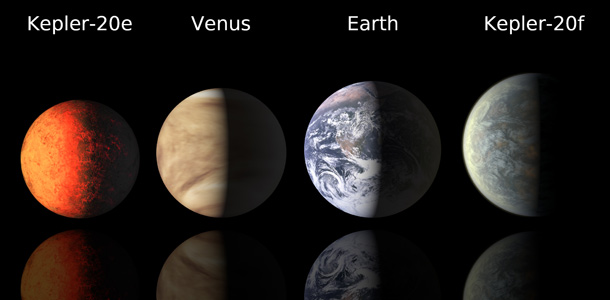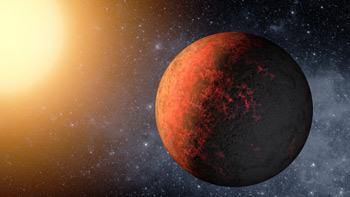Astronomers have achieved a big milestone in the search for another Earth: the two smallest confirmed planets ever found orbiting another star… and they’re both about the size of Earth!
 |
| Artist’s illustration of the Kepler-20 planets with Earth and Venus for size comparison. |
The planets are called Kepler-20e and Kepler-20f, and as you can see by the illustration above they are very close to the same size as our home world: 20e is about 11,100 km (6900 miles) in diameter, and 20f about 13,200 km (8200 miles) across. For comparison, Earth has a diameter of 12,760 km (7930 miles). This makes them the smallest confirmed exoplanets seen orbiting another star! The previous record holder was Kepler-10b, which has a diameter about 40% bigger than Earth’s.
To be clear: while these planets are the size of Earth, they are nowhere near Earth-like. The star, Kepler-20, is very much like the Sun, though a bit smaller and cooler (and 950 light years away). However, both planets orbit the star much closer than Earth does; 7.6 million km (4.7 million miles) and 16.6 million km (10.3 million miles), respectively. This is so much closer that both planets must have surface temperatures far hotter than ours, 760°C and 430°C (1400°F and 800°F). Even on the “cooler” planet Kepler-20f, it’s hot enough to melt tin and zinc.
So don’t start packing your bags to visit, even if you could spare a few million years to get there via rocket (950 light years is a bit of a hike). I’ll note that we don’t know the masses of these planets either. I’ll explain that in a moment, but given their sizes it’s expected they’ll have masses similar to Earth’s.
 So this is very exciting! For one thing, it shows that Kepler can indeed find planets the size of Earth orbiting distant stars. That right away is fantastic; that’s the main goal of Kepler in the first place.
So this is very exciting! For one thing, it shows that Kepler can indeed find planets the size of Earth orbiting distant stars. That right away is fantastic; that’s the main goal of Kepler in the first place.
For another, it shows that our solar system is not entirely unique. We do know of several other stars hosting solar systems of their own, but those planets tend to be very massive; they’re easier for us to find. Since Kepler-20e and f are so close to Earth-sized, this is a big achievement.
And we’re still not done: there are three other planets in the Kepler-20 system! The others are much larger than the Earth: named Kepler-20b, c, and d, they have diameters of 24,000, 40,000, and 35,000 km (15,000, 24,600, and 22,000 miles); smaller than Uranus and Neptune, but still pretty hefty. We do have the masses for them: 8.7, 16.1, and about 20 times the mass of the Earth. Call them “super-Earths” if you like.
All these planets huddle pretty closely to their star; the orbit of Kepler-20f, the farthest from the star, would still fit comfortably inside the orbit of Mercury! Oddly, the configuration is very different than our own solar system. While ours has the lower-mass planets close in and the bigger ones farther out, in the Kepler-20 system they alternate, going big-little-big-little-big.
So how do we know all this? The Kepler observatory is in space, staring at one patch of sky all the time. There are 100,000 stars in its field of view, including Kepler-20. If there are planets orbiting a star, and we see the orbit of that planet edge-on, then once per orbit the planet directly passes between us and the star, blocking its light a little bit. This is called a transit, and the bigger the planet, the more light it blocks. That’s how the sizes of the five planets were found.
As these planets orbit their star their gravity tugs on it, and that can be measured by carefully observing the star’s light. As a planet pulls it one way and then another, there is a very small Doppler shift in the starlight, and the amount of that shift tells us how hard the planet is tugging on the star, and that in turn depends on the mass of the planet. Only the three bigger planets in the Kepler-20 system pull hard enough for us to measure, which is why we don’t have the masses of 20e and 20f; they’re too small to measure.
Also, to be clear, we don’t have direct images of these planets (those pictures above are drawings). They were found indirectly by how they affected their star. But these methods are now tried-and-true, and the existence of these five planets has been confirmed. They’re real.
This is a fantastic discovery for so many reasons: the smallest planets found orbiting another star, the first Earth-sized planets seen by Kepler, both in the same solar system, and in such an oddly-configured and compact system at that. This means we need to think more about how such planets can form, of course, since it’s so weird… but no matter what, it means we’re that much closer to finding the ultimate goal: an Earth-sized planet orbiting a Sun-like star in that star’s habitable zone, where liquid water can exist.
Every time I hear news like this, I wonder how much longer we’ll be waiting to hear that news… and I strongly suspect it won’t be too much longer.
Image credit: NASA/Ames/JPL-Caltech
Related posts:
- Kepler confirms first planet found in the habitable zone of a Sun-like star!
- A boiling superEarth joins the exoplanet roster
- Big news: first “solid” exoplanet found!
- Two exoplanets discovered by “citizen scientists”